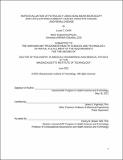Rapid evaluation of pathology using nonlinear microscopy with applications in breast cancer, prostate cancer, and renal disease
Author(s)
Cahill, Lucas C.
DownloadThesis PDF (12.12Mb)
Advisor
Fujimoto, James G.
Terms of use
Metadata
Show full item recordAbstract
Frozen section analysis (FSA) is used intraoperatively for rapid evaluation of surgical tissue. In FSA, excised tissue is rapidly frozen, sectioned using a microtome, stained with hematoxylin and eosin (H&E), and evaluated by a pathologist. FSA requires ~20 minutes for the first specimen to be evaluated and the specimen size is limited by the equipment and personnel available. In some tissues that have a high lipid content (such as breast), freezing is difficult and adds artifacts that can affect interpretation. Techniques that enable fresh surgical specimen evaluation without freezing or microtoming can reduce the time and labor required for intraoperative tissue analysis. Nonlinear microscopy (NLM) is a fluorescence microscopy technique that provides subcellular resolution images of tissue using a femtosecond laser to excite fluorescence at the laser focus. Tissue does not need to be microtomed enabling visualization of freshly excised tissue. Exogenous fluorophores can be used to visualize cellular components such as nuclei and cytoplasm/stroma and multiple specimens can be stained in parallel without the restrictions of tissue size associated with FSA. NLM could dramatically reduce the time required for tissue evaluation compared with FSA.
In this thesis, we developed and validated NLM evaluation techniques for breast and prostate cancer and renal disease. The studies in this thesis were performed in close collaboration with the Beth Israel Deaconess Center. We developed a rapid, robust fluorescent staining protocol for NLM imaging with a compact, low cost ytterbium laser and validate it on fresh breast tissue. A randomized controlled trial was designed and initiated to assess the rate of indication for repeat breast surgeries in a study group of patients receiving intraoperative NLM evaluation vs a control group of patients receiving no intraoperative evaluation. We also developed techniques for NLM evaluation of fresh prostatectomy tissue and prostate biopsies and performed blinded readings of NLM images to assess accuracy. An optical clearing and staining technique for rapid three-dimensional analysis of renal biopsies was developed. Overall, this thesis aims to provide a new approach for intraoperative/intraprocedural consultation with NLM, potentially enabling more accurate, rapid, and simplified surgeries/procedures.
Date issued
2021-06Department
Harvard-MIT Program in Health Sciences and TechnologyPublisher
Massachusetts Institute of Technology